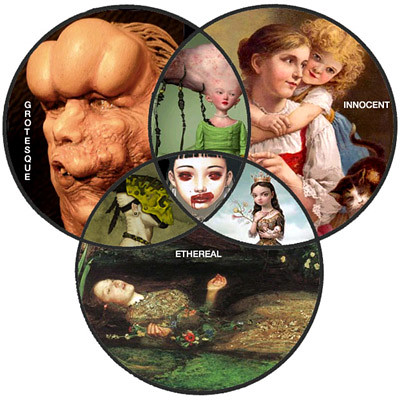But Is it Babyart?
I’m a huge fan of the Babyart Livejournal Community, where people post pictures of tentacled, glass-eyed, pigtailed nymphettes that resemble broken dolls and frequently have their arm in a sling. The term “babyart” was originally just the title of Trevor Brown’s art website (don’t click it, mom!), but has since broadened to refer to the type of themes found in the art of Mark Ryden, Ray Caesar, David Stoupakis, Lori Earley and a number of other people who probably hate the idea that I’m mentioning them all in the same sentence together.
Once in a while, some misguided soul wanders onto the Babyart LJ thinking it’s a community about “Art, But With Babies In It” and posts something like this. Some people may like these pictures, but personally, it’s not why I joined the community. No, for me, this is what it’s all about! And this, and this, and this. One day a few months ago I got so fed up with the off-topic posts that I created this handy Venn Diagram to help establish some guidelines, a kind of subjective pocket guide:

My Babyart Venn Diagram was a hit. Still, I’ve still yet to figure out why “Babyart” has become such a huge phenomenon in the past few years, why this generation has embraced its themes like never before. Was there some show we all watched as kids that warped us into lovers of disturbing-cuteness? Is it some sort of cultural awareness of a loss of innocence? Any theories?
Credits!
Outside circles: The Elephant Man by Paul Komoda, random Victorian trading card, Ophelia by Millais.
Inner images, clockwise: Ray Caesar, Mark Ryden and Brom.
Center: The Zen of Babyart, as achieved by Trevor Brown.

October 12th, 2007 at 1:17 pm
Yes! I remember you showing me this diagram a while ago – hilarious and accurate!
October 12th, 2007 at 8:19 pm
I think it may have to do with people’s desire to subvert what’s traditionally been perceived as perfection. Ironically, the subversion can often backfire and make something yet more beautiful than the original. Much like the appeal of tattered lace, or crumbling architectural ruins, it makes you feel there is a story behind the facade ~ blending perfection with decay…
October 12th, 2007 at 8:58 pm
Perhaps it’s due in part to the novelty of magazines like Juxtapoz which have recently become widely available at mainstream corporate bookstores like Barnes & Noble. I mean, you don’t have to seek out new art movements anymore to view pop surrealist artwork if it’s available at the checkout of Wal-Borders in Midwest-ville; maybe novelty is the ‘attractive’ factor right now.